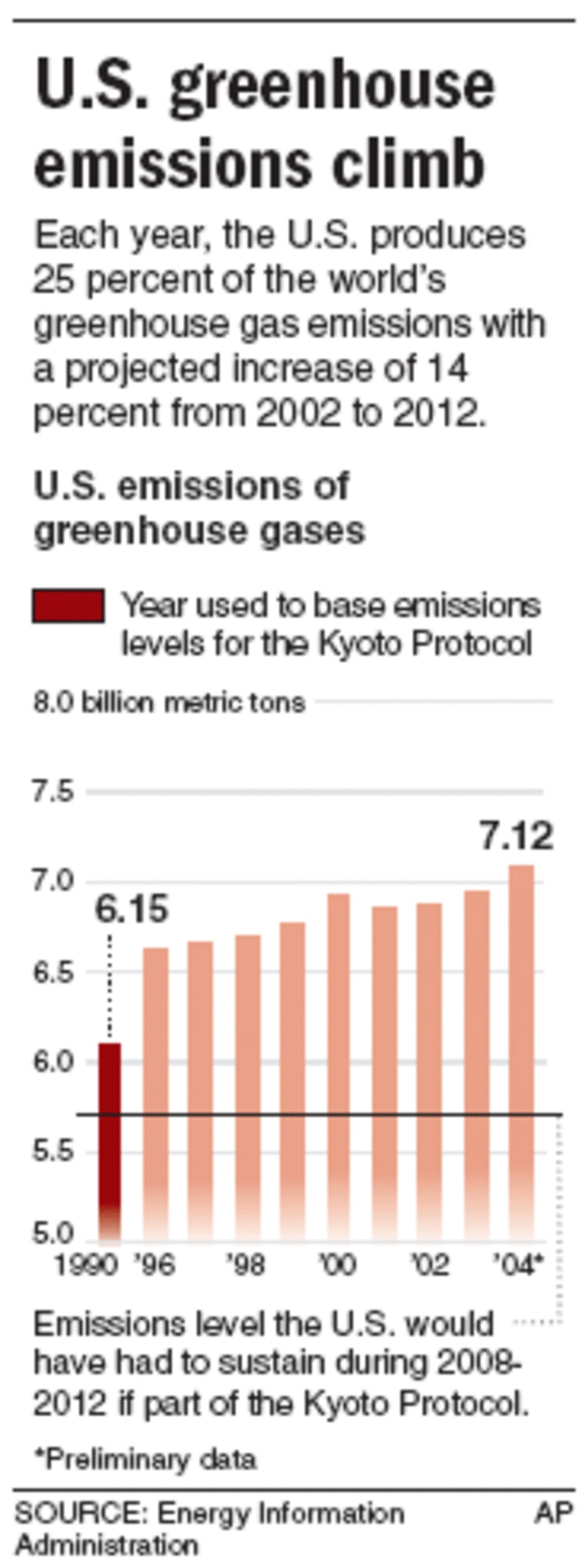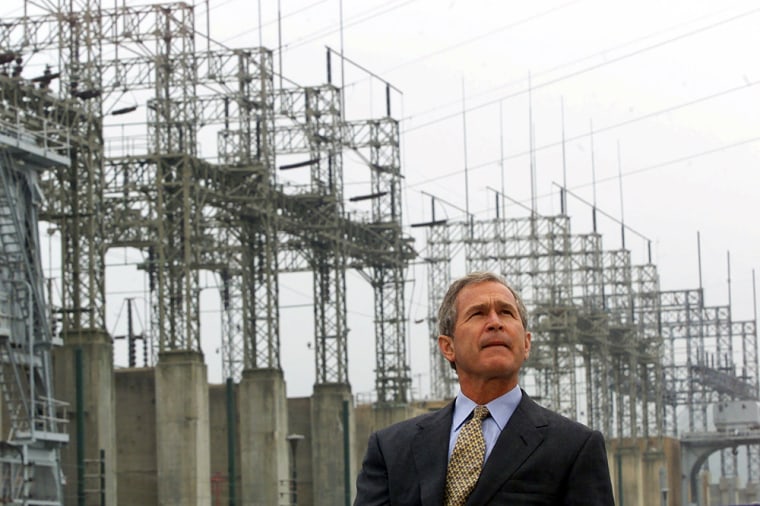When it comes to global warming, the Bush administration puts its faith in volunteerism and new energy technologies to scale back America’s Everest of heat-trapping gases. But government studies say the results are at best uncertain.
One thing is not: Each year, the mountain of “greenhouse” gases emitted by the United States grows bigger.
While the rest of the developed world requires — but isn’t always achieving — mandatory cuts in carbon dioxide and other emissions, the nation adding the most gases to the atmosphere is deadlocked in a debate over how to deal with it. Individual states, meanwhile, are taking the lead.
Voluntary programs emphasized by President Bush since 2002 are claimed to be sparing the atmosphere 300 million tons of carbon dioxide a year, or 4 percent of U.S. emissions.
But the government doesn’t know — and often can’t verify — whether the reductions reported by 230 U.S. companies are real.
“It’s difficult to prove,” said Paul McArdle, who manages the Energy Department’s voluntary reporting system. “It’s my sense that some of these are real reductions.”
What’s more, McArdle acknowledged, companies can increase their emissions overall but still claim cutbacks — by counting as reductions such steps as replacing old lighting, using more efficient vehicles or planting trees.
In a review last April, Congress’s Government Accountability Office questioned Washington’s ability to monitor these voluntary efforts. “Determining the reductions attributable to each program will be challenging,” it said.
In one program with measurable results, it estimated companies have reduced emissions by no more than one-half of 1 percent of U.S. greenhouse gas pollution. Total U.S. emissions — now more than 7 billion tons a year — still are projected to rise 14 percent from 2002 to 2012.
Focus on reducing 'intensity'
Carbon dioxide from burning coal, oil and other fossil fuels is the biggest of the greenhouse gases, so called because they create a heat-trapping blanket when released into the atmosphere. Others are methane, nitrous oxide and synthetic gases. The atmosphere holds more carbon dioxide now than it has for hundreds of thousands of years, and the Earth’s surface warmed an average 1 degree over the past century.
As a first step, the White House talks of reducing the “intensity” of U.S. carbon pollution — not shrinking emissions overall, but reducing the carbon dioxide emitted per unit of economic growth.

“Our objective is to significantly slow the growth of greenhouse gas emissions and, as the science justifies, stop it and then reverse it,” said James Connaughton, chairman of the White House Council on Environmental Quality. “We’re making good progress. It’s reasonably ambitious, but it still provides for reasonable human welfare.”
Shortly after taking office, President Bush rejected the 1997 Kyoto Protocol, which requires 36 industrial nations to cut global warming gases by 2012 by an average 5 percent below 1990 levels.
He argued that cutting the U.S. share to below 6 billion tons a year, as the treaty would have required, would have cost 5 million U.S. jobs. He objected, too, that such high-polluting developing nations as China and India are not required to reduce emissions.
Some members of Congress agree with the gradualist Bush approach, while others do not, Republicans among them.
“Everybody’s talking about it. What the American people want is for somebody to start doing something about it,” complained Rep. Sherwood Boehlert, R-N.Y., House Science Committee chairman.
“If we can’t make a relatively simple change in (automobile) mileage regulations — a change to an existing regulation that doesn’t even require new technology and that would have numerous benefits aside from the climate implications — then what does that say about our ability to reduce greenhouse gas emissions?” Boehlert said. “It certainly doesn’t say anything good.”
Instead, the United States is spending $3 billion each year researching technologies to cut global warming and $2 billion on climate research. In a program called the Asia-Pacific Partnership, Bush also is working with Australia, China, India, Japan and South Korea — producers of half the world’s greenhouse gases — to attract private money for cleaner energy technologies.
Connaughton calls that joint effort a major breakthrough. Sen. Jim Jeffords, I-Vt., a senior member of the Senate Environment and Public Works Committee, calls it an “excuse for further delay.”
Technology plan 'appears stalled'
Bush envisions using more hydrogen-powered vehicles, electricity from renewable energy sources and clean coal technology.
The Energy Department’s technology program has helped build 34,000 new energy-efficient homes and it plans to create “bioenergy” research centers and to advance research into hydrogen fuel and fusion energy. Its director, Stephen Eule, promises breakthroughs in the coming decades.
Scientists say climate disruptions may occur before that, however, and critics in Congress and elsewhere say the government effort is too slow and needs refocusing.
The plan “appears stalled near the starting line,” said Rep. Judy Biggert, R-Ill., who chairs a House subcommittee overseeing the program. A review in May by the Energy Department’s own research lab in Oak Ridge, Tenn., said the program focuses too much on work that can lead to “only incremental improvements.” It called for more emphasis on “exploratory, out-of-the-box concepts.”
“There is a need for more high-risk but high-payoff research,” the review concluded.
A new government economic analysis sees markets in combination with research as the way to go.
Put a price on carbon?
The Congressional Budget Office report last month said any cost-effective U.S. policy on global warming must put a price on carbon — via an emissions tax or a “cap and trade” system of buying and selling emissions allowances among companies, as in Europe.
“Setting a current price for carbon emissions and announcing planned future carbon prices not only would induce firms and households to change their behavior but also would increase their demand for technologies that would reduce emissions,” CBO researchers said.
States aren’t waiting for Washington.
On Sept. 28, Gov. Arnold Schwarzenegger signed California legislation imposing a first-in-the-nation emissions cap on utilities, refineries and manufacturing plants, with a goal of cutting greenhouse gases to 1990 levels by 2020. An earlier California law ordered 30-percent reductions in greenhouse gas emissions from new motor vehicles. And Schwarzenegger and British Prime Minister Tony Blair announced plans this summer to work toward a possible joint emissions-trading market.
Such a market pact is close to becoming reality among eight Northeastern and Mid-Atlantic states, which plan to impose caps on power plant emissions and encourage trading of allowances among utilities. Twenty-eight states in all have drawn up plans to combat warming, with some — notably Alaska, Arizona, Montana, New Mexico and North Carolina — also working toward possible mandatory limits on gases. Ten states plan to enact California’s auto rule, if it survives a current court challenge.
Some businesses want national caps now on carbon emissions, believing them inevitable. “It is very difficult to have a product that is regulated significantly differently from state to state,” said Bill Gerwing, environmental policy director for the oil company BP America.
Political football
Contributing to Washington’s impasse is skepticism in some quarters about whether global warming is even a problem.
The Senate Environment chairman, Sen. James Inhofe, R-Okla., likens concerns about the Earth warming to Chicken Little saying the sky is falling.
“Global warming is an alarmism. It’s a type of a hoax,” said Inhofe. “The reality is that a cap on carbon is a cap on the economy, through the rationing of energy.”
Similar thinking pervades the House, Boehlert said. “The scientific consensus has simply not pierced through the ideological barriers,” he said.
Former Rep. Claudine Schneider, R-R.I., who in 1988 led the first major legislative attempt to curb greenhouse gases, said next month’s congressional elections could provide the “most important push” in the debate.
In her current job of helping the Environmental Protection Agency recruit companies to cut carbon, she finds more shareholders viewing climate change as a top concern, she said.
“You’ve got the push of shareholders and eventually the pull of Congress moving America,” Schneider said. “We just need a new Congress.”
